We need to read codes, here's how. BACKFIRES Preliminary Checks Check vacuum hose routing. Check spark plug wiring for incorrect firing order. Symptom Checks Perform the following: Ã Â Â Check ignition system. See IGNITION SYSTEMS in appropriate appropriate I - SYSTEM & COMPONENT TESTING article below. Ã Â Â Perform QUICK TEST. See appropriate TESTS W/CODES - EEC -IV article below. If code is present, perform appropriate CIRCUIT TEST. Ã Â Â TESTS W/CODES - EEC-IV (4.9L) Ã Â Â TESTS W/CODES - EEC-IV (5.0L) Ã Â Â TESTS W/CODES - EEC-IV (5.8L) Ã Â Â TESTS W/CODES - EEC-IV (7.5L) Ã Â Â Check air injection (if equipped). See EMISSION SYSTEMS & SUB-SYSTEMS in appropriate I - SYSTEM & COMPONENT TESTING article below. Ã Â Â Check engine mechanical condition. Check compression, intake manifold gasket, camshaft, valve train components, etc. Ã Â Â Check fuel delivery system. See FUEL SYSTEM in appropriate appropriate I - SYSTEM & COMPONENT TESTING article. Ã Â Â SYSTEM/COMPONENT TESTS - EEC-IV (4.9L) Ã Â Â SYSTEM/COMPONENT TESTS - EEC-IV (5.0L) Ã Â Â SYSTEM/COMPONENT TESTS - EEC-IV (5.8L) Ã Â Â SYSTEM/COMPONENT TESTS - EEC-IV (7.3L DIESEL) Ã Â Â SYSTEM/COMPONENT TESTS - EEC-IV (7.5L)RETRIEVING CODES Diagnostic trouble codes are retrieved from EEC-IV system through Data Link Connector (DLC). Various methods and test equipment may be used to access these codes: Ã Â Â Analog Volt-Ohmmeter (VOM). Ã Â Â Scan tester. Ã Â Â Malfunction Indicator Light (MIL)/CHECK ENGINE light. Ã Â Â STAR Series Tester DATA LINK CONNECTOR (DLC) LOCATIONS READING CODES KOEO & KOER SELF-TEST Codes PCM outputs codes one digit at a time. These codes indicate current faults in system and should be serviced in order of appearance. Use DIAGNOSTIC TROUBLE CODE REFERENCE CHART to identify correct CIRCUIT TEST. If using an analog voltmeter or CHECK ENGINE light or Malfunction Indicator Light (MIL), pay careful attention to length of pauses in order to read codes correctly. Digits in DTC will be displayed by a needle pulse sweep (analog voltmeter) or a flash (MIL). Diagnostic Trouble Codes (DTCs) are represented by a 3-digit number. For example, the first digit of DTC 312 would be displayed by 3 sweeps/flashes with a 0.4-second pause in-between each sweep/flash. A 2-second pause will occur between first and second digits of DTC. Second digit of DTC 312 will be displayed by one sweep/flash then another 2-second pause. Third digit of DTC 312 will be displayed by 2 sweeps/flashes with a 0.4 pause in-between each sweep/flash. A 4-second pause occurs between each code. See Fig. 1 . KOE O codes are separated from Continuous Memory codes by a 6 to 9-second delay, a 0.4-second sweep/flash (separator pulse) and then another 6 to 9- second delay. See Fig. 2 . Scan tester, if used, will count pulses and display them as a digital code. STAR tester cannot be used to read 3-digit codes. Super STAR II or New Generation STAR tester can be used to read 3-digit codes. If using Super STAR II tester, 3-digit codes will only be displayed in fast code mode. If slow code mode is used, display will be blank. CAUTION: Continuous Memory Codes should be recorded when retrieved. These codes may be used to identify intermittent problems that exist after all KOEO and KOER codes have been repaired and a Code 111 (pass code) has been obtained. Some Continuous Memory Code faults may not be valid after KOEO and KOER codes are serviced. Application Location All Models Left Rear Of Engine CompartmentEngine Identification (ID) Codes Engine ID codes are issued at beginning of KOER SELF-TEST. Codes are one-digit numbers represented by number of pulses displayed. See Fig. 2 . Engine ID code is equal to one-half the number o f engine cylinders. For example, 2 pulses would indicate that engine is a 4-cylinder. Engine ID code is used to verify proper PCM is installed and that SELF-TEST has been entered. Separator Code Single 1/2-second separator pulse is issued 6-9 seconds after last KOEO code. Continuous Memory Codes (intermittent faults) are then displayed 6-9 seconds after 1/2-second separator code. See Fig. 2 . Some digital test equipment may display separator code as "10" instead of "1". Pass Codes A Code 111 indicates no diagnostic trouble codes were recorded in that portion of test; system passes that portion of test. If Code 111 is not retrieved in KOEO SELF-TEST, codes retrieved during KOER SELF-TEST may not be valid. Code 111 (pass code) must be obtained in KOEO SELF-TEST. A Code 111-1-111 output during KOEO SELF-TEST indicates no KOEO code or Continuous Memory Code was recorded. Continuous Memory Codes Continuous Memory Codes are displayed after separator pulse code in KOEO SELF-TEST. These codes result from information stored by PCM during continuous self-test monitoring. These codes indicate faults recorded within last 40 engine starts (80 engine starts on some models). Fault may or may not be currently present. See DIAGNOSTIC TROUBLE CODE DEFINITION CHARTS . Use these codes for diagnosis only when KOEO SELF-TEST and KOER SELF-TEST result in Code 111. Fast Codes At start of KOEO SELF-TEST and after Wide Open Throttle (WOT) request in KOER SELF-TEST, PCM outputs short bursts of information, known as FAST CODES, which were used by manufacturer during assembly. These codes contain the identical information as slow codes, but are transmitted at 100 times the normal rate. With most equipment (except Super Star II tester), these code bursts are not visible. An entire code sequence lasts less than 1/2 second. Fig. 1: Reading Diagnostic Trouble Codes Using MIL/CHECK ENGINE Light (Using Analog Voltmeter Is Similar) Courtesy of FORD MOTOR CO. Fig. 2: Reading Diagnostic Trouble Codes (7.5L) Courtesy of FORD MOTOR CO. CLEARING CODESTo clear codes from PCM memory, start KOEO SELF-TEST. When diagnostic trouble codes appear on test equipment or Malfunction Indicator Light (MIL), disconnect jumper wire from Self-Test Input (STI) connector. If using STAR Series Tester, unlatch center button. This procedure erases Continuous Memory Codes from PCM memory. If problem has not been corrected or fault is still present, hard code will immediately be reset in PCM memory.
CAUTION: DO NOT disconnect vehicle battery to clear codes. This will erase stored operating information from Keep-Alive Memory (KAM). CAUTION: When battery is disconnected, vehicle computer and memory systems may lose memory data. Driveability problems may exist until computer systems have completed a relearn cycle. See COMPUTER RELEARN PROCEDURES article in GENERAL INFORMATION section before disconnecting battery.
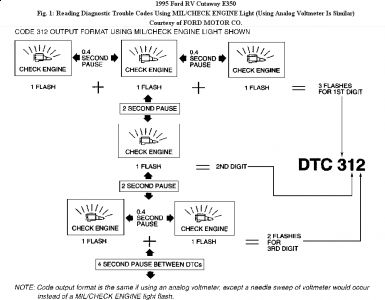
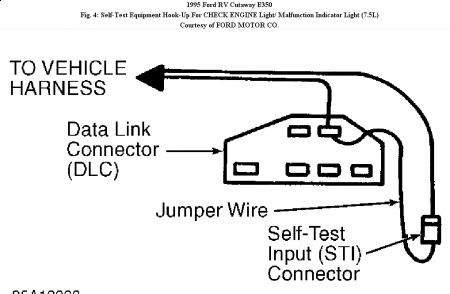
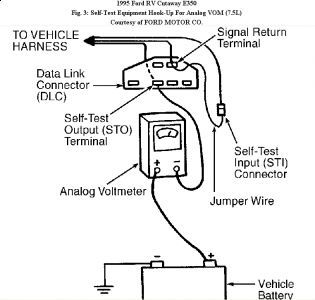
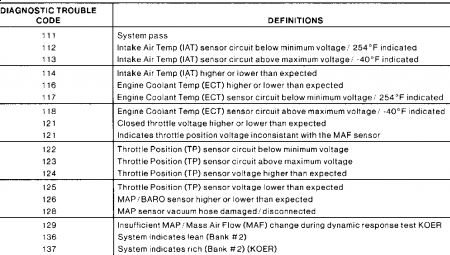
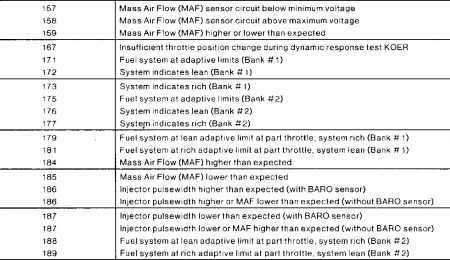

Sunday, August 2nd, 2009 AT 12:39 PM







